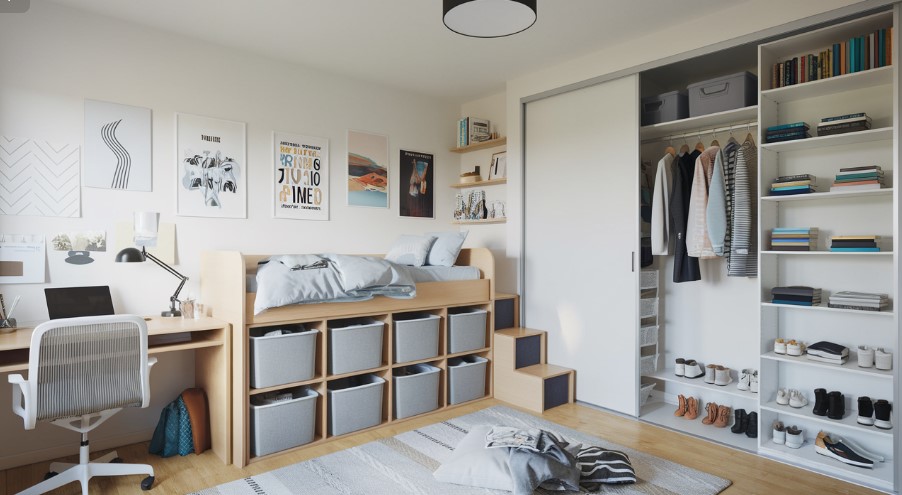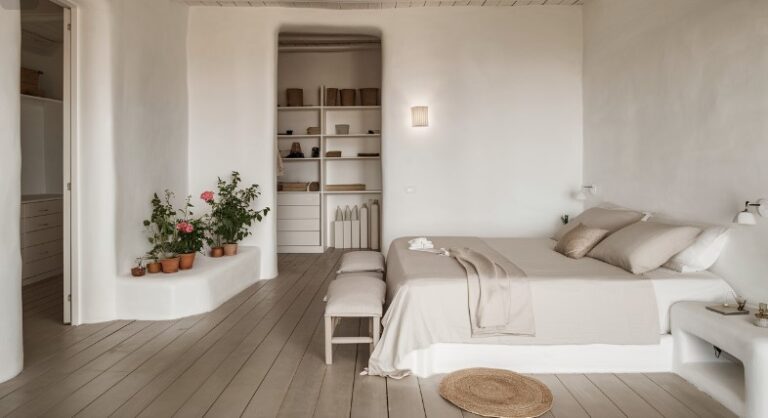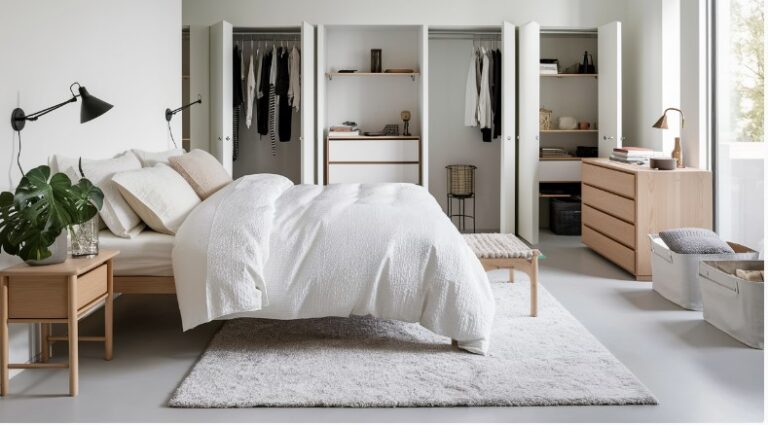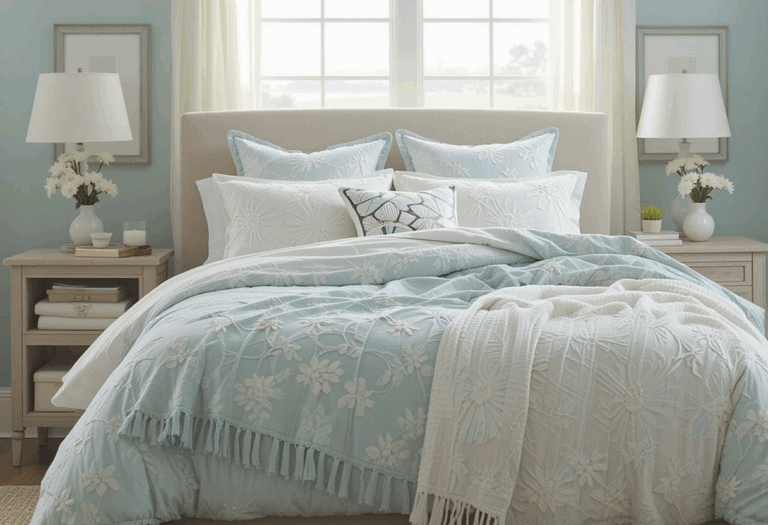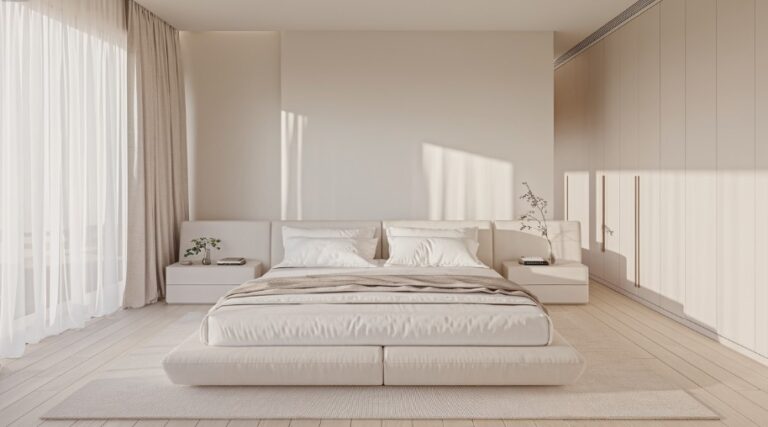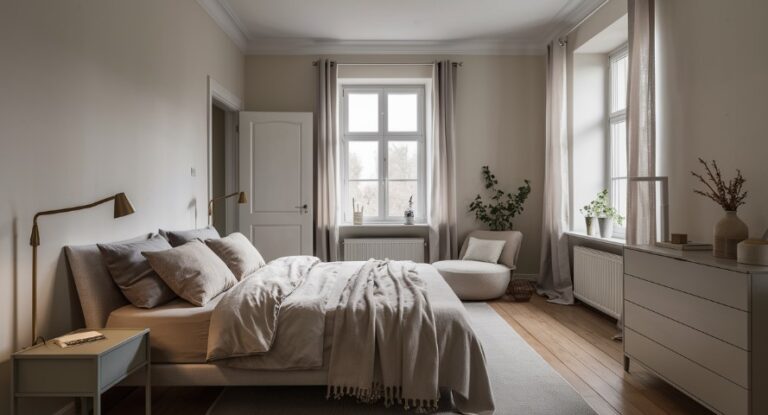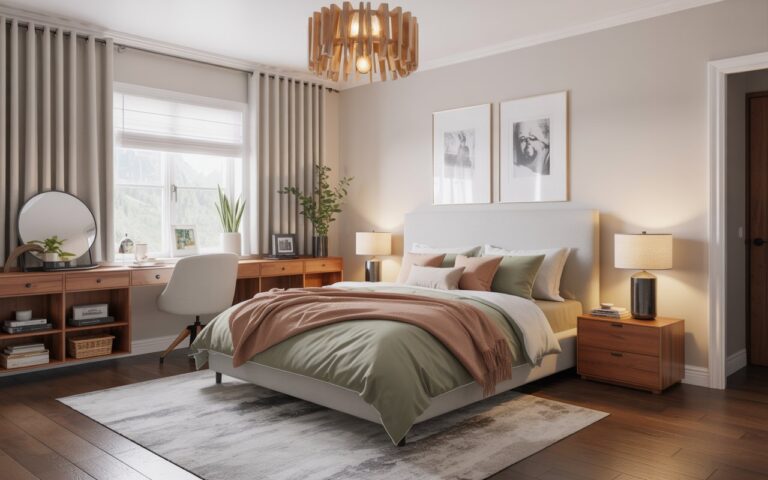8 Teen bedroom decluttering Tips
Helping a teenager declutter their bedroom can be tough, but rewarding. An organized room brings calm and boosts focus and productivity.
Our guide, “Teen Bedroom Decluttering Tips,” offers practical strategies. It helps your teen take control of their space.
These tips will turn their room into a neat, functional haven. They cover sorting school supplies and finding the best storage for their hobbies.
Join us as we uncover how a tidy space can help your teen. It can make their room a place to relax, study, and grow. Dive in and discover how to turn clutter into clarity with our step-by-step advice.
1. Establish a decluttering mindset
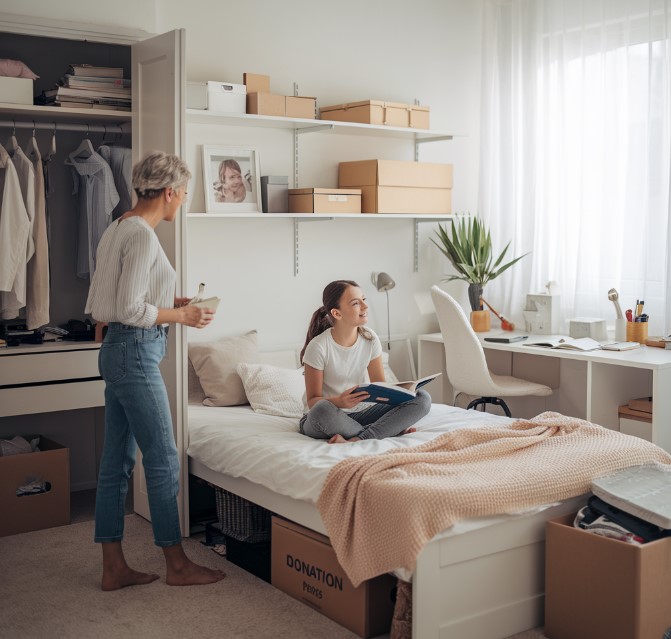
To declutter a teen’s room, adopt a decluttering mindset. This mindset values simplicity and the benefits of an organized space.
Start with an open talk. Explain the benefits of decluttering. A clean room boosts focus and reduces stress. It also makes studying and relaxing easier.
Encourage setting clear goals. Teens should decide what’s important. Do items bring joy or serve a purpose?
Tackle one area at a time—like the closet, desk, or under the bed. Ask if each item was used in the past year and if it adds value.
This mindset helps teens discard unnecessary items and stay organized.
2. Set realistic goals and timelines
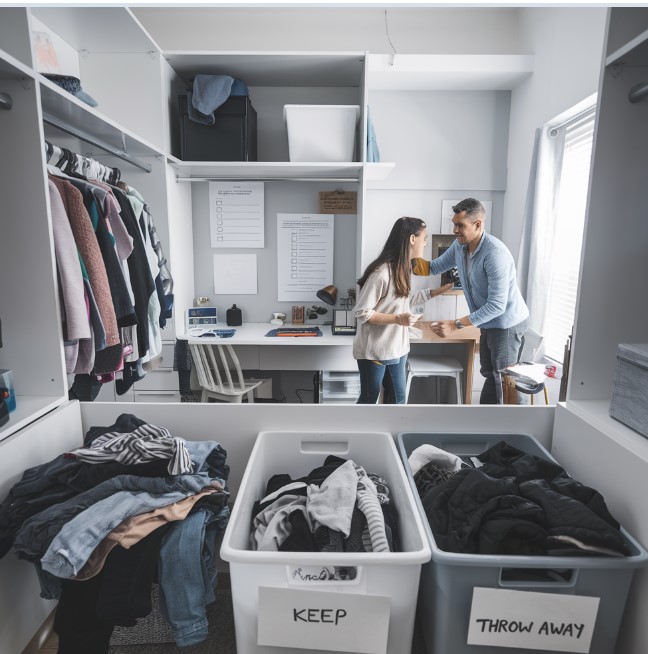
Cleaning a teen’s room can be a big change. First, make a plan. Gather essential supplies: bags for trash, boxes for donations, and containers for keepsakes. This helps the process stay smooth and organized.
Next, set achievable goals and deadlines. Break the task into small parts. For instance, sort clothes one day, then books the next. This keeps things manageable.
Involve your teen. Talk about goals and their vision for the room. This ensures the process meets their needs and preferences.
The aim is to create a space that works well and is enjoyable. Realistic goals and timelines ease stress for everyone.
3. Gather necessary supplies (e.g., storage containers, labels, trash bags)
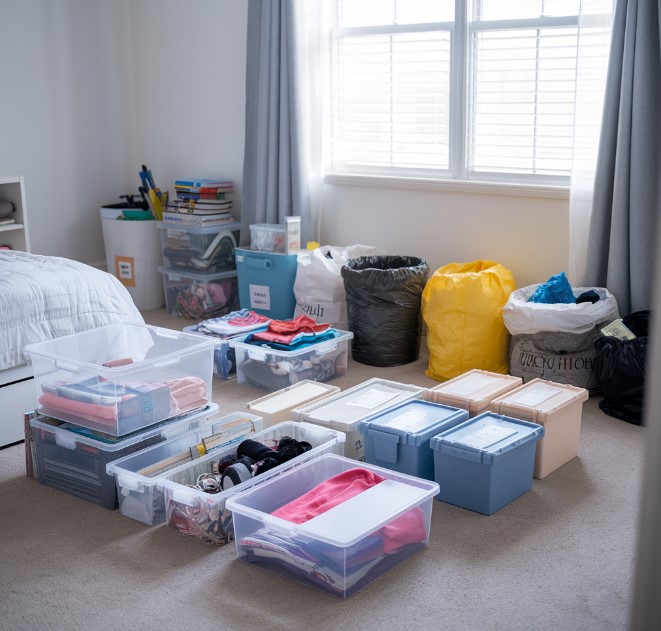
To declutter a teen’s room, gather some supplies: storage bins, labels, and trash bags.
Use containers to organize items. Choose various sizes for clothes, books, accessories, and keepsakes. Clear containers are best. They allow for easy visibility, making it simple to find things.
Labels are crucial too. Mark each container. This helps your teen know where things belong, keeping the room organized.
For unwanted items, trash bags are a must. Separate bags for trash, recycling, and donations make sorting easy. This ensures proper disposal.
With these tools, you’re ready for a stress-free room makeover.
4. Start with a clean slate (remove everything from the room)
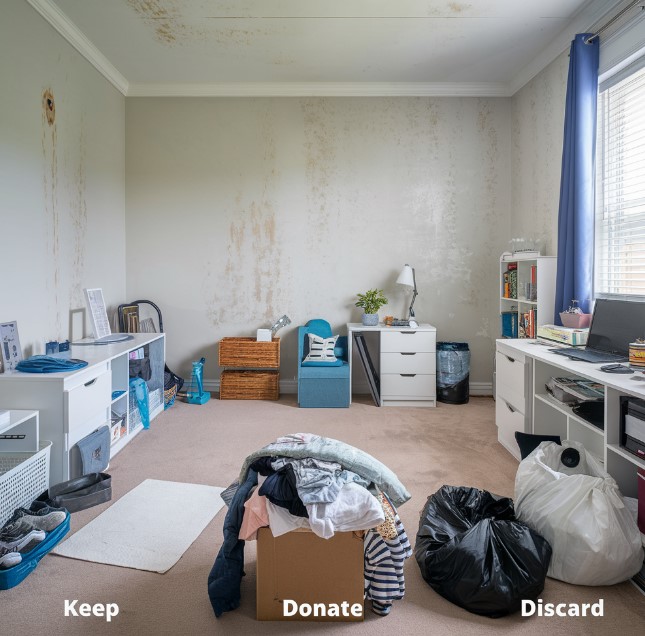
Cleaning a teen’s room can be a big change.
Make a plan; Gather essential supplies: bags for trash, boxes for donations, and containers for keepsakes, This helps the process stay smooth and organized.
Set achievable goals and deadlines; Break the task into small parts. For instance, sort clothes one day, then books the next. This keeps things manageable.
Involve your teen, Talk about goals and their vision for the room. This ensures the process meets their needs and preferences.
The aim is to create a space that works well and is enjoyable. Realistic goals and timelines ease stress for everyone.
5. Sort items into categories (e.g., clothes, books, electronics, memorabilia
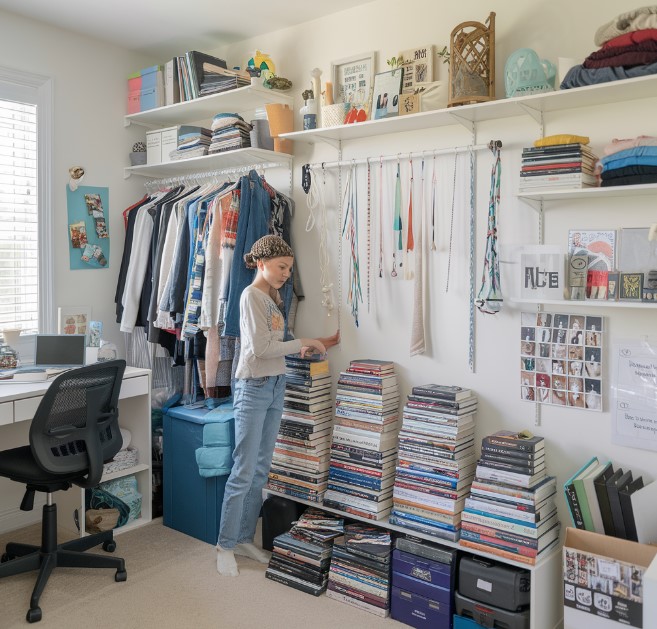
When decluttering a teen’s bedroom, sorting items is essential. First, gather everything. Then, divide items into categories like clothes, books, electronics, and memorabilia.
This method shows the amounts in each category. It helps decide what to keep, donate, or throw away.
For clothes, have your teen try on each piece and only keep well-fitting, dispose worn items.
Books should be sorted by genre, this allows keeping favorites and removing duplicates or old ones.
Check old gadgets and chargers. Decide whether to keep or recycle them.
Memorabilia like tickets and awards are tougher to part with, Consider a memory box or creative display to keep them.
Categorizing items helps teens understand their possessions. It leads to a more organized bedroom, improving relaxation and productivity.
6. Purge items you no longer need or use
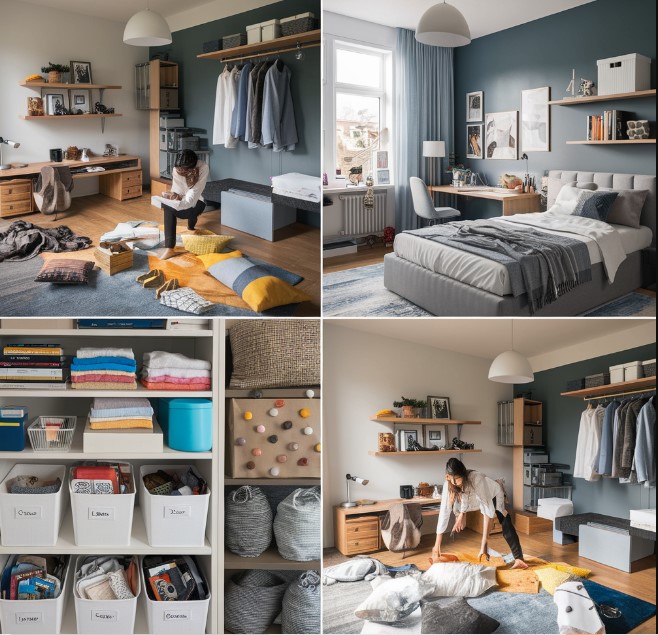
Cleaning a teen’s room can be easy with the right steps. First, remove unneeded items. Ask your teen if each item is useful or joyful. If not, suggest donating or throwing it away.
Next, group items like clothes, books, and gadgets. Use bins, shelves, or under-bed space to store them. Labeling helps keep order.
Create areas for studying, relaxing, and sleeping. This makes the room more useful and cuts clutter.
Get your teen involved. It builds their decision-making and gives them ownership. Celebrate their work and set a regular cleaning schedule.
These steps will tidy the room and boost your teen’s calm and productivity.
7. Find a home for every item you keep
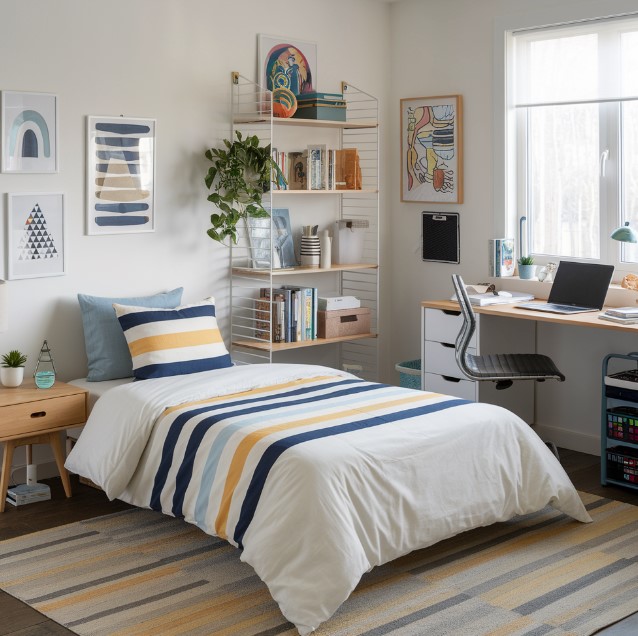
Cleaning a teen’s room goes beyond tidying. It’s about boosting productivity and relaxation. Key is giving every item a specific spot.
Assign places for clothes, books, gadgets, and personal items. Use bins, shelves, and dividers for organization.
Organize clothes by type or color. This makes mornings quicker and encourages tidiness. Store shoes and accessories in under-bed spaces or closets.
Books and supplies can fit in desk organizers. This fosters a better study space.
Set up charging stations for gadgets. This avoids clutter.
Teach your teen to return items after use. This habit keeps the room tidy and builds responsibility.
Having a spot for everything makes a room efficient. It supports your teen’s growth.
8. Invest in multi-purpose furniture (e.g., storage beds, ottomans)

To declutter a teen’s room, choose smart furniture. This boosts space and organization. Key pieces are multipurpose.
For example, a storage bed with drawers or shelves can hold clothes, shoes, or bedding.
Ottomans with hidden storage serve as extra seats and keep books, toys, and accessories.
Modular furniture is also a good choice. It adapts to changing needs.
This allows teens to update their space as they grow, then think about wall-mounted shelves or floating desks, they free up floor space and make the room feel bigger.
Use bins and organizers for small items in drawers and closets. This keeps jewelry and school supplies tidy and easy to find.
Encourage your teen to make a habit of getting rid of unused items.
Use these tips and smart furniture to transform your teen’s room. It will be a functional, organized space they’ll love.
Conclusion
In conclusion, decluttering a teen’s bedroom is more than cleaning. It involves creating a space that helps them focus, relax, and grow.
Smart storage solutions can make a difference, enhance furniture that serves many purposes and modular organizers.
These allow teens to reclaim their space and show their personality. Regular upkeep is key.
Involving them in this task helps them take ownership of their space. A clutter-free room boosts organization and mental health.
It also improves sleep and productivity. These tips help teens declutter. They can then create a room that reflects their changing interests. It will be a space where they can thrive and feel at home.
1. How can I motivate my teenager to declutter their bedroom?
Making a teenager to clean their room can be tough, but it’s possible.
First, suggest doing it together, Talk about how it can reduce stress and boost focus.
Let them decide what to keep, donate, or throw away. Explain that this makes it easier to find things and improves their space.
Break the task into small, easy goals.
Offer help with storage or taking things to donate.
Encourage them to make the space their own, This could mean moving furniture or adding personal decor.
Consider offering rewards. For example, treat them after they finish or take them out.
Recognize their efforts and progress. This builds positive habits.
Show that cleaning can be a fun, and an empowering experience, This will encourage them to stay organized.
2. What are some creative storage solutions for a teen’s bedroom?
Creative storage solutions for a teen’s bedroom save space and keep it organized.
Under-bed storage is a great option. Bins or drawers can hold seasonal clothes, extra bedding, or shoes, freeing up closet space.
Wall-mounted or floating shelves save floor space for books, décor, and personal items.
Multifunctional furniture, such as a bed with drawers, combines seating or sleeping with storage. Hanging organizers , over-the-door shoe racks are great for accessories, jewelry, and school supplies.
Place decorative baskets or bins on shelves or under desks. They will keep everyday items tidy yet accessible.
Tall bookshelves or storage towers make use of vertical space. They can hold electronics, games, or art supplies, keeping the room open and spacious.
These solutions provide storage. They let teens personalize their space with functional décor. They let them express their style.
3. How do I handle sentimental items my teen doesn’t want to part with?
You must respect your teen’s feelings about their sentimental items. But, you must also be practical. It’s a delicate balance.
First, acknowledge their attachment and the value of these items. Then, encourage discussion about their significance.
Next, sort items together by importance and space limits. Suggest taking photos to keep memories without the items.
Create a small, organized storage space. This encourages your teen to be selective.
Make routine checks on these items. See if they’re still attached or ready to part with some.
Finally, create a supportive environment. Your teen should feel heard and involved.
This approach respects their attachment. It provides a subtle direction toward a more meaningful, manageable collection.
4. Should I involve my teen in the decluttering process, and if so, how?
Involving your teenager in decluttering offers many benefits. It teaches vital organizational skills for adulthood.
They learn to assess their belongings, deciding what to keep, donate, or discard. This process fosters a sense of responsibility for their space.
It also promotes independence and self-reliance. Moreover, involving your teen encourages family communication and teamwork.
Doing tasks together creates bonding. It leads to talks about preferences, lifestyle changes, and a tidy home.
Teens get to share their views, feeling valued in decisions about their spaces.
To engage your teen, start by discussing the benefits of decluttering. Then, set clear goals together.
Encourage them to sort their belongings and offer help when needed. Respect their choices to promote independence.
Make it fun. Play music, set timers, and celebrate milestones. A team effort makes decluttering positive, empowering your teen and teaching them organization.
5.What are the benefits of decluttering for teenagers?
Decluttering benefits teenagers more than just cleaning their space.
It enhances mental clarity and reduces stress. An organized environment is crucial during tough times.
A tidy space also boosts productivity and focus. It helps teens study and finish tasks without distractions.
Moreover, decluttering teaches important life skills. Teens learn decision-making and responsibility. They decide what to keep, donate, or throw away. This builds independence.
It also fosters pride in a clean space, boosting self-esteem and well-being.
A clutter-free space improves family relationships. It promotes harmony and reduces conflicts.
Teens feel more comfortable inviting friends over, strengthening social connections.
Decluttering also sets good habits for the future. It prepares teens for adulthood, helping them manage time and reduce stress.
So, decluttering is more than a clean room. It’s vital for growth and well-being in crucial years.
